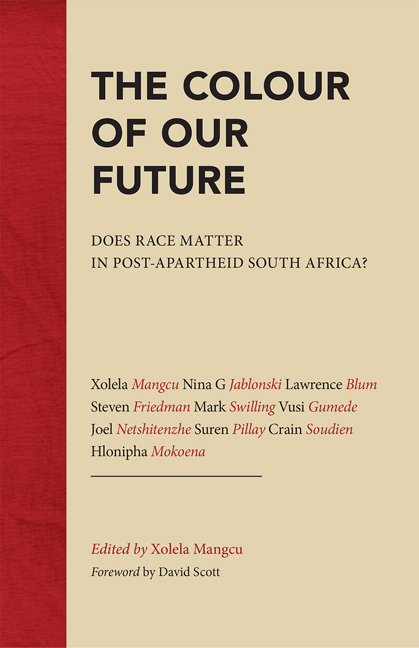Book contents
- Frontmatter
- Dedication
- Contents
- Figures and tables
- Acronyms and abbreviations
- Foreword
- Preface
- Chapter One What Moving Beyond Race Can Actually Mean: Towards a Joint Culture
- Chapter Two The Colour of Our Past and Present: The Evolution of Human Skin Pigmentation
- Chapter Three Races, Racialised Groups and Racial Identity: Perspectives from South Africa and the United States
- Chapter Four The Janus Face of the Past: Preserving and Resisting South African Path Dependence
- Chapter Five How Black is the Future of Green in South Africa's Urban Future?
- Chapter Six Inequality in Democratic South Africa
- Chapter Seven Interrogating the Concept and Dynamics of Race in Public Policy
- Chapter Eight Why I Am No Longer a Non-Racialist: Identity and Difference
- Chapter Nine Interrogating Transformation in South African Higher Education
- Chapter Ten The Black Interpreters and the Arch of History
- Notes
- Contributors
- Index
Chapter Five - How Black is the Future of Green in South Africa's Urban Future?
Published online by Cambridge University Press: 20 April 2018
- Frontmatter
- Dedication
- Contents
- Figures and tables
- Acronyms and abbreviations
- Foreword
- Preface
- Chapter One What Moving Beyond Race Can Actually Mean: Towards a Joint Culture
- Chapter Two The Colour of Our Past and Present: The Evolution of Human Skin Pigmentation
- Chapter Three Races, Racialised Groups and Racial Identity: Perspectives from South Africa and the United States
- Chapter Four The Janus Face of the Past: Preserving and Resisting South African Path Dependence
- Chapter Five How Black is the Future of Green in South Africa's Urban Future?
- Chapter Six Inequality in Democratic South Africa
- Chapter Seven Interrogating the Concept and Dynamics of Race in Public Policy
- Chapter Eight Why I Am No Longer a Non-Racialist: Identity and Difference
- Chapter Nine Interrogating Transformation in South African Higher Education
- Chapter Ten The Black Interpreters and the Arch of History
- Notes
- Contributors
- Index
Summary
Spatial segregation is likely to be a persistent feature of the postapartheid city, as historical and contemporary processes driven by race and income inequality are reinforced by land availability and financial constraints on house and services delivery.
In this chapter I draw on my own experience of trying to build a socially integrated, ecologically designed neighbourhood in order to take up Jennifer Robinson's challenge to address the ‘continuities and discontinuities in the causal processes that shape segregation’. Like others who have written about the persistence of segregation and inequalities in African cities in terms of continuities and discontinuities with the colonial legacy, I address the enduring racial and class divisions across the South African urban landscape.
These divisions contradict the visions of social integration articulated in the Integrated Development Plans (IDPs) that have been approved each year by post-apartheid municipalities. And yet, there is not much that helps explain this contradiction in ways that go beyond mere policy inadequacy or state incapacity. And it is no longer good enough to blame this on the apartheid legacy or ‘white interests’. As will be discussed below, the capital subsidy for low-income housing introduced by the first minister of housing, Joe Slovo, effectively sank in concrete the racial structure of the apartheid city.
This chapter examines the capital subsidy, together with banking and municipal rating systems, to help explain the persistence of apartheid socio-spatial urban forms. For possible discontinuities we may be able to look to the new ‘green agenda’. Since 2008 the South African government has become increasingly committed to the idea of building a more sustainable or ‘green’ economy. Does this relatively new discourse provide new opportunities for addressing persistent racially configured class divisions? Or will the dull compulsion of prevailing patterns of landownership, planning, infrastructure and resource allocation continue to reinforce the continuities of segregation?
CONTESTING INTEGRATION
There are three interconnected systems that reproduce continuities from the apartheid past in ways that are not readily apparent to anyone working within a conventional development framework. The conventional development approach consists of projects that cater either for the poor who qualify for housing subsidies or for those who can afford home loans to purchase homes costing from R600 000 upwards. We simply accept that it will be inevitable that these two types of project will happen in different parts of town.
- Type
- Chapter
- Information
- The Colour of Our FutureDoes race matter in post-apartheid South Africa?, pp. 65 - 90Publisher: Wits University PressPrint publication year: 2015

